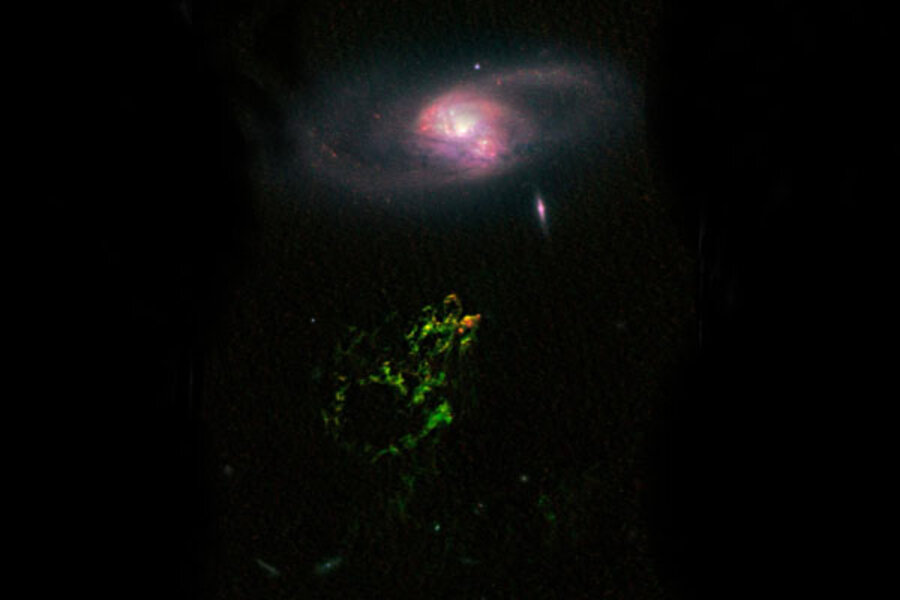Scientists investigate intergalactic space blob: What is it?
Loading...
Astronomers hunt exotic objects – black holes, gamma-ray bursters, or mighty magnetars.
Now, some of them are tracking down the elusive Voorwerpjes.
The what?
Voorwerpjes is an informal moniker astronomers have given to odd blobs of glowing gas that appear to be floating free of any nearby galaxy – showing up in spots where no gas should glow, at least at visible wavelengths.
The first of these objects was discovered three and a half years ago by Dutch schoolteacher Hanny van Arkel as part of a citizen-science program called Galaxy Zoo.
Recent observations of the Milky Way-sized structure, dubbed Hanny's Voorwerp (object), suggest that these blobs could serve as beacons, alerting astronomers to what may be the presence of a recently quenched quasar at the heart of a galaxy near the object.
Studying galaxies with newly-quenched quasars – galaxies that would be obscured by the brilliance of the quasar itself when it ws active – could yield fresh insights on the influence quasars have on the evolution of the galaxies they inhabit, says William Keel, an astronomer at the University of Arizona in Tucson who is deeply involved in the hunt.
So far, his team has confirmed an additional 18 "Voorwerpjes" out of a larger body of candidates that Galaxy Zoo participants identified after examining 18,000 images of galaxies with active quasars at their cores. Each of these 18 glowing expanses of gas span at least 32,000 light-years.
Some of these have been spotted before, Dr. Keel acknowledges, but others are new.
"One of the new ones is immense, fully half the size of Hanny's Voorwerp itself," he says.
At a briefing Jan. 11 during the American Astronomical Society's winter meeting in Seattle, Keel described Hanny's Voorwerp as an "unprecedented object."
The object is in the neighborhood of a galaxy known as IC 2497, a spiral galaxy, like the Milky Way. It lies 650 million light-years away from Earth in the constellation Leo Minor.
After Ms. van Arkel spotted the object, astronomers began observing it with different telescopes and at various wavelengths.
Radio observations revealed that the glowing blob of gas, located some 200,000 light-years beyond IC 2497, was part of a vast streamer of cold hydrogen gas that stretches some 300,000 light-years and tips the scales at 8 billion times the mass of the sun.
Researchers suspect that a close gravitational encounter or merger with another galaxy ripped the streamer away from IC 2497 at some point in its past. The galaxy's spiral arms also appear twisted, supporting this hypothesis.
Yet cold hydrogen gas needs a source of radiation to ionize it and light it up. Young, hot stars are a typical source of such radiation, but early observations showed that the glowing gas hosted no stars.
The only other source that can deliver enough radiation would be a quasar – a supermassive black hole that gobbles up dust and gas at a prodigious rate. The radiation comes from the intense heat generated in the accretion of dust and gas swept ever closer by the black hole's immense gravity.
The accretion disk is the materials' last stop before oblivion. The radiation typically leaves the galaxy in narrow jets that vault from the galaxy's center along its axis of rotation. If the galaxy is viewed edge-on, the visible evidence of a quasar is obscured by dust and gas. But viewed beam-on, these are among the brightest objects in the universe.
In IC 2497's case, no quasar was evident. Either the quasar was obscured by dust and gas, as often is the case, or it had gone dormant.
To peer through the dust and gas, a team led by Yale University astrophysicist Kevin Schawinski used X-ray observations and found a supermassive black hole at the galaxy's center, but one whose radiation was 10,000 times less than the level needed to light up Hanny's Voorwerp.
The team says its evidence suggests that while the quasar was active, its beam hit a section of the streamer, ionizing the gas. They concluded that Hanny's Voorwerp was an afterglow from the now-quiet quasar, whose supermassive black hole is estimated to have 1 billion times the sun's mass.
This cosmic bulb went dim, researchers say, because the black hole has changed its mode of operation. Instead of releasing energy from the accretion disk as radiation, it's releasing energy as motion – charged particles streaming outward, pushing adjacent gas away from the black hole.
The team estimates that this transition from radiating to pushing began within the past 200,000 years.
What Keel dubs "unexpected evidence" for the change shows up through Hubble observations of the galaxy's center, where it appears that the black hole is blowing a bubble of gas into the galaxy's disk.
Evidence of this switch also shows up in observations of Hanny's Voorwerp, Keel says. On close examination, Hubble images show evidence of stars forming in one – and only one – small region of the glowing gas.
Radio telescope data show a jet of gas flowing from the galaxy in the direction of Hanny's Voorwerp.
Keel posits that the stream is colliding with a small region of gas on the outskirts of Hanny's Voorwerp. The collision compresses the gas in the area, triggering the gravitational collapse of hydrogen that begins the star-forming process.
This outflow is relatively mild, Keel says, although it may be ramping up as the quasar shifts its modus operandi.
The quest to find more of these Voorwerpjes has been stimulated by "the utter unlikelihood that the one quasar out of huge numbers" that have quenched so quickly "would happen to have been the closest to us and the easiest to see," Keel says.





